RightBattery.com
Tests and reviews of different batteries to help you find the Right One…
Search
Posts Tagged ‘AA battery’
1.5V AA Duracell Procell Alkaline Battery Tests
26, Jul 2013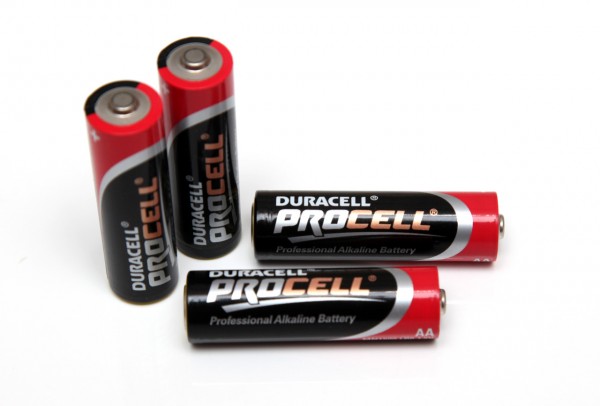
The 1.5V AA Duracell Procell Alkaline batteries we’ve got for testing are what Durcell provides for professional and business use – the Duracell Professional is the business-to-business division of Duracell. The batteries we’ve got for testing are under warranty until 03-2019 and Duracell mentions shelf life of about 7 years for these batteries. What Duracell mentions about these batteries is that they can operate in temperature extremes between -20°C and +54°C, and that the Procell batteries are ideal for applications such as torches, telemeters and measuring instruments, microphones and medical devices.
According to the specifications that Duracell provides for the 1.5V AA Procell Alkaline batteries for a typical discharge performance at 21 degrees Celsius a single cell should provide about 2900mAh at 0.05A discharge current, ~2700 mAh at 0.1A, ~2300 mAh at 0.25A and about 2000 mAh at 0.5A load. These numbers however are not for constant current discharge, but instead for a duty cycle use that includes a few hours a day and we are testing with constant current discharge, so we expected to get a bit lower numbers in our tests.

The Power Profile test checks how the battery handles different current loads before it reaches the cutoff voltage, the test starts at 0A and gradually increases with steps of 0.05A each 20 seconds until it the cutoff voltage of the cell is reached. In the case of the 1.5V AA Duracell Procell Alkaline batteries we were able to reach a current load of 1.70A before the battery has reached the cutoff value of 1V, meaning that these batteries even though Alkaline are pretty capable of handling quite high current loads.
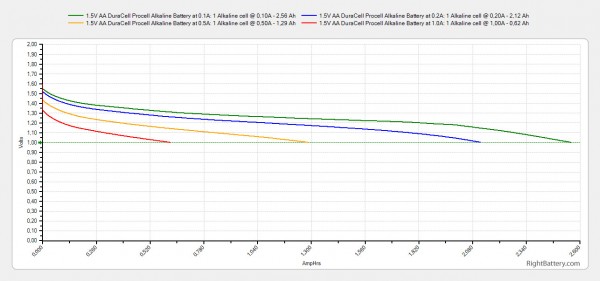
The Open Circuit Voltage (no load voltage) of the 1.5V AA Duracell Procell Alkaline batteries is 1.6V, though it quickly drops to 1.5V under load. We are testing all Alkaline batteries with a constant current load of 0.1A, 0.2A, 0.5A and 1A and measuring what capacity they can provide at these levels, and these Alkaline cells from Duracell are no exception. What was interesting here is that the Duracell Procell batteries are able to handle quite well higher current drain for a while and although there is an expected drop in the useable capacity you get even at 1A constant current load we got quite good performance out of them and this is something that is not very common for Alkaline batteries.
What we got out of the 1.5V AA Duracell Procell Alkaline batteries in our tests:
– 2557 mAh at 0.1A load
– 2120 mAh at 0.2A load
– 1287 mAh at 0.5A load
– 619 mAh at 1.0A load
– 3.182 Wh at 0.1A load
– 2.561 Wh at 0.2A load
– 1.482 Wh at 0.5A load
– 0.687 Wh at 1.0A load
Only the battery that we’ve tested with constant current discharge using 1A load got slightly hotter than the ambient temperature of 25 degrees Celsius that we are testing at. At the end of the discharge cycle the temperature of that battery has reached 31 degrees C. We were quite pleasantly surprised by the good capacity and the ability of these Alkaline batteries to handle higher loads with ease and this makes them interesting not only for low drain applications that typically Alkaline batteries are used for, but also for applications where higher current load may be required as they are apparently able to handle well in such situations.
– To download a datasheet with the manufacturer’s battery specifications…
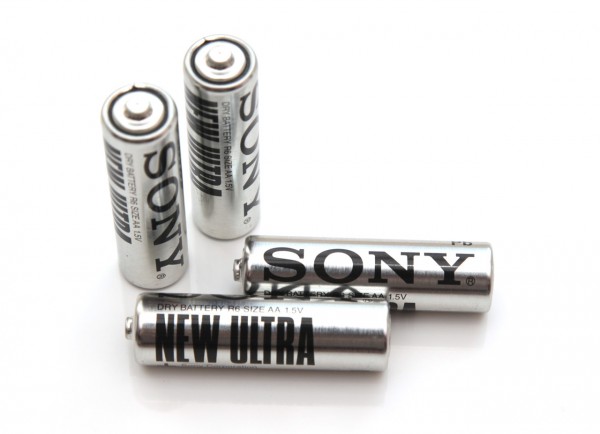
The 1.5V AA Sony Ultra Heavy Duty Carbon Zinc batteries we’ve got for testing here are marked with a code SUM3-NUB4A on their box, they are under warranty until 03-2015. We could not find specifications for these batteries provided by Sony, the only thing Sony does is to say that they are: “Ideal for use in low drain applications such as remote controls, torches, toys, calculators and radios”. And don’t be fooled by the Heavy Duty in the name, with Zinc-carbon batteries this usually means you get the slightly better version and not the the lower capacity ones, however even these are performing worse than standard Alkaline batteries.
Zinc–carbon batteries are the least expensive primary batteries (single use ones) and are intended for low current drain applications. These batteries are getting harder to find as they are mostly being replaced by Alkaline batteries (slightly more expensive and better performing), however you can still find slightly cheaper Carbon Zinc batteries mixed among Alkaline batteries in a store, so you should be careful when choosing based on your needs. For higher drain applications it is advisable to consider Alkaline or even NiMH batteries over Zinc–carbon ones.
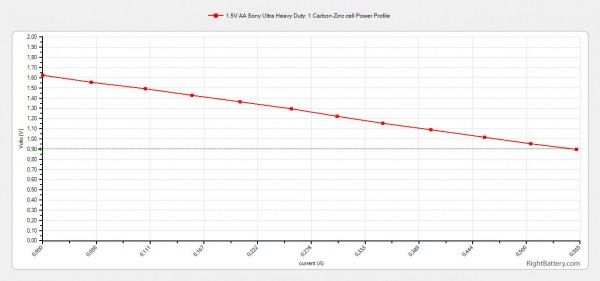
The Power Profile test checks how the battery handles different current loads before it reaches the cutoff voltage, the test starts at 0A and gradually increases with steps of 0.05A each 20 seconds, until it the cutoff voltage of the cell is reached (0.9V in the case of Zinc-carbon cells). In the case of the 1.5V AA Sony Ultra Heavy Duty Carbon Zinc batteries when a current load of 0.55A is applied the battery’s voltage quickly drops to the cutoff value, meaning that the battery is unable to handle such high current loads. As expected the Zinc-Carbon batteries are not able to handle higher current draw as good as Alkaline batteries for example as they are intended for lower current drain applications than Alkaline.
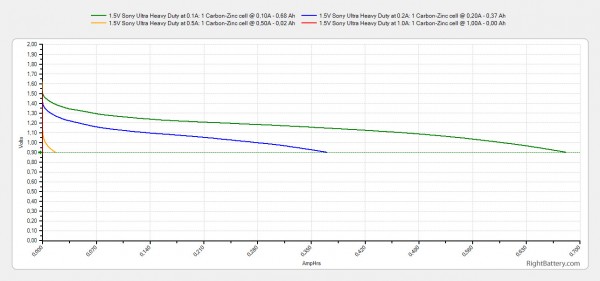
The Open Circuit Voltage (no load voltage) of the 1.5V AA Sony Ultra Heavy Duty Carbon Zinc batteries is 1.62V, though under load it quickly drops to 1.5V or lower depending on the current load of the battery. We are testing all Carbon Zinc as well as Alkaline batteries with a constant current discharge rate of 0.1A, 0.2A, 0.5A and 1A and measuring what capacity they can provide at these levels.
What we got out of the 1.5V AA Sony Ultra Heavy Duty Carbon Zinc in our tests:
– 681 mAh at 0.1A load
– 370 mAh at 0.2A load
– 17 mAh at 0.5A load
– 0 mAh at 1.0A load
– 0.783 Wh at 0.1A load
– 0.398 Wh at 0.2A load
– 0.016 Wh at 0.5A load
– 0 Wh at 1.0A load
As expected from a Zinc-carbon battery the capacity you can get under low current load is decent, but as you increase the load the useable capacity drops quite significantly. So the 1.5V AA Sony Ultra Heavy Duty Carbon Zinc batteries may not be bad as long as you are using them only for the right things – devices with low power requirements.
1.5V AA Energizer Industrial Alkaline Battery Tests
24, Jul 2013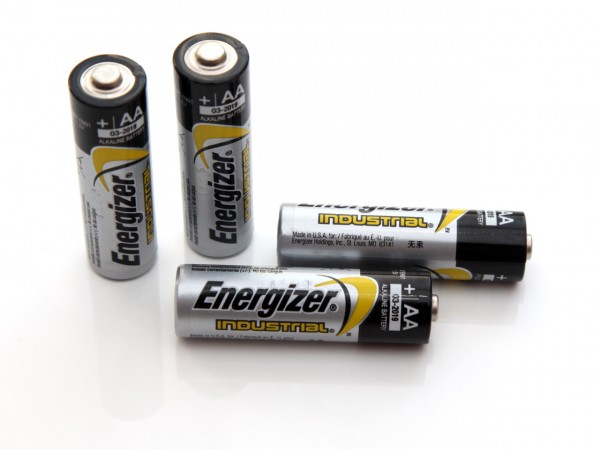
The Milliamp-Hours Capacity of the 1.5V AA Energizer Industrial Alkaline batteries that Energizer provides for continuous discharge to 0.8 volts at 21°C is as follows: ~2800mAh at 25 mA load, ~2500mAh at 100 mA load, ~1900mAh at 250 mA load, ~1400mAh at 500 mA load. The 0.8V is the voltage for a totally discharged Alkaline battery cell, however we are testing with a cutoff voltage of 1V as at a voltage of 0.8V a lot of devices may not be able to function properly. Also we are testing at 25°C room temperature and the different temperature means different internal resistance and as a result it is expected to get a different capacity results.

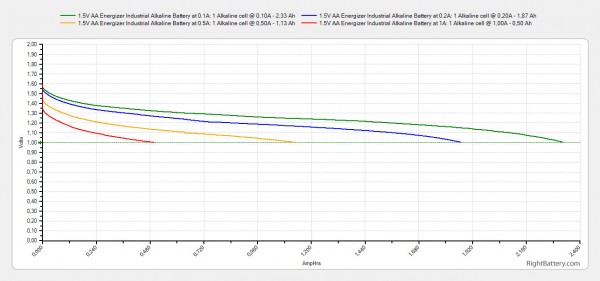
What we got out of the 1.5V AA Energizer Industrial Alkaline batteries in our tests:
– 2236 mAh at 0.1A load
– 1869 mAh at 0.2A load
– 1129 mAh at 0.5A load
– 500 mAh at 1.0A load
– 2.887 Wh at 0.1A load
– 2.251 Wh at 0.2A load
– 1.285 Wh at 0.5A load
– 0.554 Wh at 1.0A load
The overall results we got are very satisfactory for an Industrial type Alkaline battery, and we’ve already mentioned why our results may be different than what Energizer provides as information about the capabilities of these batteries. Our tests show that the 1.5V AA Energizer Industrial Alkaline batteries are performing very well and they should be able to perform even better in situations with lower current requirements such as 0.025A for example.
– To download a datasheet with the manufacturer’s battery specifications…